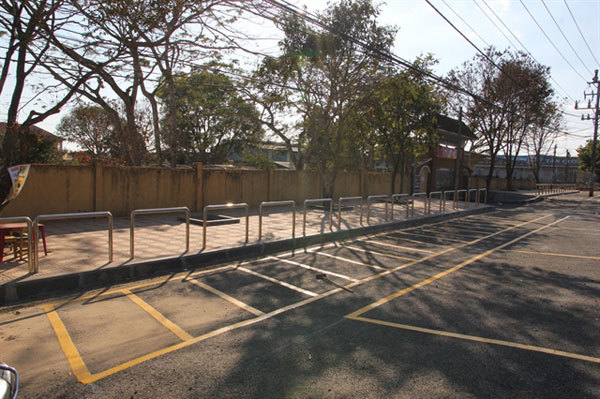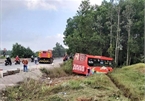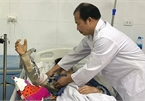 |
| The Slow Zones, Safe Zones speed-reduction programme improves the road safety environment and culture for students commuting to and from school through a comprehensive set of interventions to limit speed in school zones. — Photo courtesy of AIP Foundation |
The programme educates children and the community about the dangers of speeding, and focuses on legislative change by increasing collaboration with local government and police enforcement.
In this phase, the programme will improve safety around 30 primary schools in the province’s Pleiku City by installing minor and low-cost modifications (co-funded by the government) that are highly effective in reducing speed.
It will also advocate for a policy change by soliciting community input and government support to establish a legal school-zone definition for all future designs and renovations for schools in Pleiku. A standard school zone does not exist in Vietnam.
A national road safety e-curriculum which features interactive videos, games and activities designed to teach students life-saving skills will be expanded to other provinces in the country. The adoption of the e-curriculum as a national resource is the best way to benefit the youngest people across Vietnam and keep them safe when travelling.
Khuat Viet Hung, deputy chairman of the National Traffic Safety Committee, said: “Twenty-five per cent of road crashes are caused by speeding, so speed reduction can lower the risks of serious injury or death.”
Mirjam Sidik, CEO of AIP Foundation, said: “According to the Institute for Health Metrics and Evaluation, which is an independent global health research centre at the University of Washington, 2,150 children lose their lives on Vietnam’s roads every year. This is unacceptable.”
“When we know that pedestrians have only a 10 per cent chance of survival if in a collision with a vehicle driving at 60 kilometres per hour, but have a 90 per cent chance of survival if the car is driving at 30 kilometres per hour, there is never an excuse for speeding, especially near school zones. We must take immediate action to protect our children from preventable tragedies,” Sidik added.
The first phase of Slow Zones, Safe Zones resulted in comparably significant speed reduction, with maximum speed at both target schools in the programme reduced by as much as 18-21 kilometres per hour.
Among self-reported student road crashes, the rate of crashes near the schools decreased from 34.1 per cent to 30.4 per cent. Additionally, according to community surveys, the percentage of people who correctly identified the current speed limit in the target school areas increased from 15.9 per cent before intervention to 65.8 per cent afterward.
The programme is carried out by the non-profit Asia Injury Prevention (AIP) Foundation in partnership with the local government in Gia Lai Province, supported by Foundation Botnar, Global Road Safety Partnership (GRSP), Nissan Motor Corporation, Federation Internationale de l’Automobile (FIA) and Kova Paint Company.
Raoul Powlowski, of the Global Road Safety Partnership, said: “Today in Vietnam, there is little or no recognition of school zones and the need to create safer environments for children who use them, let alone a standard school zone definition.” VNS

Traffic accidents kill 1,125 people in two months
A total of 2,368 traffic accidents occurred nationwide from December 15 to February 14, killing 1,125 people and injuring 1,781 others, according to the National Committee for Traffic Safety.

Stricter penalties for drunk driving help reduce road accidents
Normally, Thanh Nhan Hospital in Hanoi admits about 100-130 patients per day, but the number of emergency cases fell to 60-70 last week.
 The second phase of the Slow Zones, Safe Zones speed reduction programme will be carried out in the Central Highlands province of Gia Lai between July and March 2022, following the first phase that began in April 2018 and ended in June this year.
The second phase of the Slow Zones, Safe Zones speed reduction programme will be carried out in the Central Highlands province of Gia Lai between July and March 2022, following the first phase that began in April 2018 and ended in June this year.